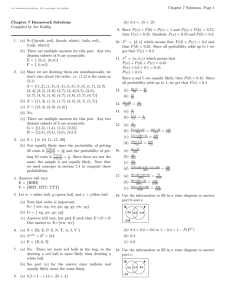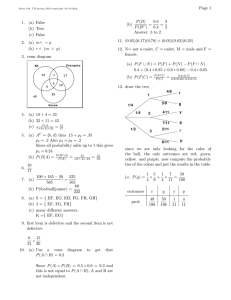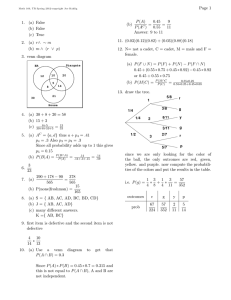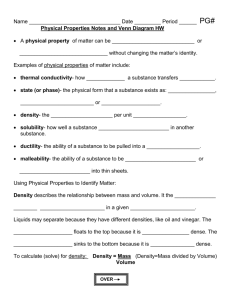Chapter 1 Solutions, Page 1 Chapter 1 Homework Solutions
advertisement
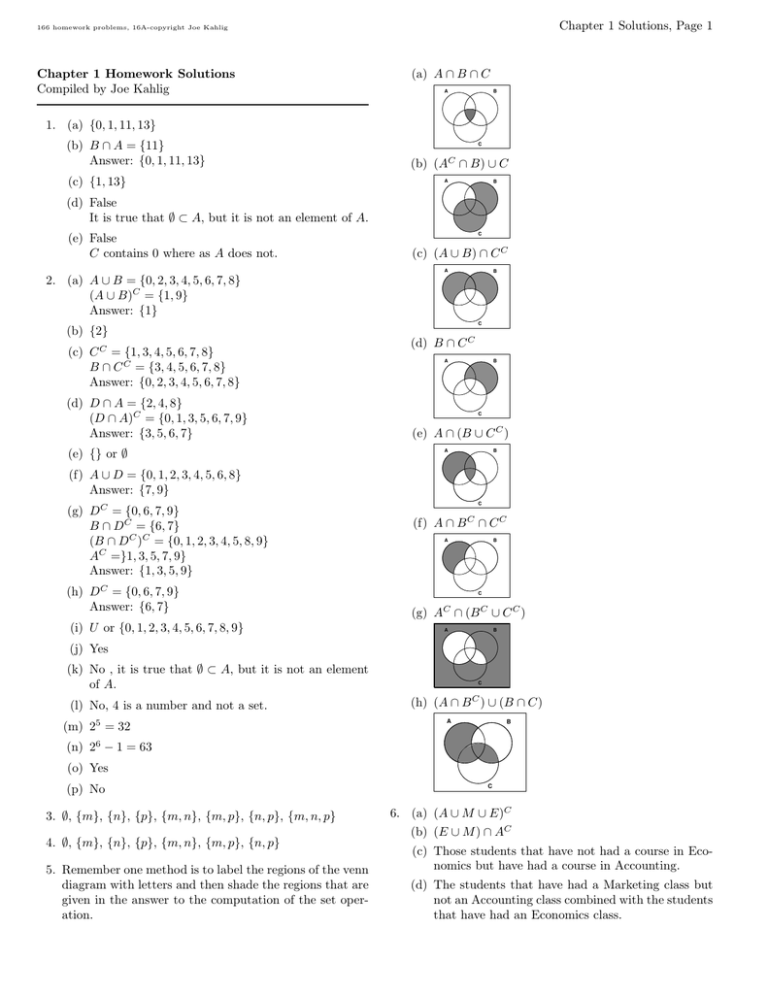
Chapter 1 Solutions, Page 1
166 homework problems, 16A-copyright Joe Kahlig
Chapter 1 Homework Solutions
Compiled by Joe Kahlig
(a) A ∩ B ∩ C
A
B
1. (a) {0, 1, 11, 13}
(b) B ∩ A = {11}
Answer: {0, 1, 11, 13}
(c) {1, 13}
C
C
(b) (A ∩ B) ∪ C
A
B
(d) False
It is true that ∅ ⊂ A, but it is not an element of A.
(e) False
C contains 0 where as A does not.
C
(c) (A ∪ B) ∩ C C
A
B
2. (a) A ∪ B = {0, 2, 3, 4, 5, 6, 7, 8}
(A ∪ B)C = {1, 9}
Answer: {1}
C
(b) {2}
(c) C C = {1, 3, 4, 5, 6, 7, 8}
B ∩ C C = {3, 4, 5, 6, 7, 8}
Answer: {0, 2, 3, 4, 5, 6, 7, 8}
(d) D ∩ A = {2, 4, 8}
(D ∩ A)C = {0, 1, 3, 5, 6, 7, 9}
Answer: {3, 5, 6, 7}
(e) {} or ∅
(d) B ∩ C C
A
B
C
(e) A ∩ (B ∪ C C )
A
B
(f) A ∪ D = {0, 1, 2, 3, 4, 5, 6, 8}
Answer: {7, 9}
(g) DC = {0, 6, 7, 9}
B ∩ DC = {6, 7}
(B ∩ DC )C = {0, 1, 2, 3, 4, 5, 8, 9}
AC =}1, 3, 5, 7, 9}
Answer: {1, 3, 5, 9}
(h) DC = {0, 6, 7, 9}
Answer: {6, 7}
(i) U or {0, 1, 2, 3, 4, 5, 6, 7, 8, 9}
C
(f) A ∩ B C ∩ C C
A
B
C
(g) AC ∩ (B C ∪ C C )
A
B
(j) Yes
(k) No , it is true that ∅ ⊂ A, but it is not an element
of A.
(l) No, 4 is a number and not a set.
(m) 25 = 32
C
C
(h) (A ∩ B ) ∪ (B ∩ C)
A
B
(n) 26 − 1 = 63
(o) Yes
(p) No
3. ∅, {m}, {n}, {p}, {m, n}, {m, p}, {n, p}, {m, n, p}
4. ∅, {m}, {n}, {p}, {m, n}, {m, p}, {n, p}
5. Remember one method is to label the regions of the venn
diagram with letters and then shade the regions that are
given in the answer to the computation of the set operation.
C
6. (a) (A ∪ M ∪ E)C
(b) (E ∪ M ) ∩ AC
(c) Those students that have not had a course in Economics but have had a course in Accounting.
(d) The students that have had a Marketing class but
not an Accounting class combined with the students
that have had an Economics class.
Chapter 1 Solutions, Page 2
166 homework problems, 16A-copyright Joe Kahlig
7. (a) (D ∪ C) ∩ F C
C
(b) D ∩ C ∩ F
C
(c) 28 = 8 + 12 + 8
or D ∩ (C ∪ F )
C
16. (a) S = { (h,r), (h,w), (t,r), (t,w)}
8. (a) 2
14
(b) there are multiple answers for this part.
E = { (h,r), (h,w)}
F = { (t,w)}
= 16384
(b) n(A ∪ B) = n(A) + n(B) − n(A ∩ B)
18 = 14 + 10 − n(A ∩ B)
n(A ∩ B) = 6
(c) A ∩ B C is how many things are in A but not in B.
Since A has 14 items and A and B have an overlap
of 6 items then there are 8 items in A but not in B.
Or use a venn diagram.
Answer: 8
17. (a) Note: since we are drawing them out simultaneously, we don’t care about the order. i.e. (1,2) is
the same as (2,1)
S = {(1, 2), (1, 3), (1, 4), (1, 5), (1, 6), (1, 7), (2, 3), (2, 4),
(2, 5), (2, 6), (2, 7), (3, 4)(3, 5), (3, 6), (3, 7), (4, 5), (4, 6),
(4, 7), (5, 6), (5, 7), (6, 7)}
9. n(A ∪ B) = n(A) + n(B) − n(A ∩ B).
n(A ∪ B) = 15 + 12 − 7
n(A ∪ B) = 20
(b) E = {(1, 3), (1, 5), (1, 7), (3, 5), (3, 7), (5, 7)}
(c) F = {(2, 4), (2, 6), (4, 6)}
(d) no, missing the one even and one odd draws.
10. n(A ∪ B) = n(A) + n(B) − n(A ∩ B).
25 = 15 + n(B) − 7
n(B) = 17
(e) There are multiple answers for this part.
G = {(1,3), (1,4), (1,5), (2,3)}
H = {(2,5), (3,4), (3,5), (4,5)}
11. venn diagram
18. S = { 6, 10, 11, 15, 20}
Basketball
Football
23
27
19. Answers will vary.
12
15
E = {HHH}
F = {HHT, HTT, TTT}
5
10
7
8
Hockey
20. let w = white ball, g=green ball, and y = yellow ball.
(a) S= { ww, wg, wy, gw, gg, gy, yw, yq}
12. It is not necessary to make a venn diagram, but it helps.
(b) G = { wg, gw, gy, yg}
B
A
23
10
(c) answer will vary. pick E such that E ∩ G = φ
E={ww, wy}
7
15
21
18
25
C
21. (a) S = {R, E, P, S, N, T, A, I, V }
(b) 2n(S) = 29 = 512
(a) 119
(c) E = {E,A, I}
(b) 23 + 21 + 18 = 62
(c) 23
(d) 25 + 21 = 46
22. (a) not equally likely since the chance of drawing a red
ball is more likely than drawing a white ball.
(b) see part a for the answer since uniform and equally
likely mean the same thing.
13. (a) 20 + 15 + 10 + 8 + 12 + 9 = 74
(b) 10
(c) 10 + 15 + 9 + 12 + 20 + 45 + 60 = 171
23. (a)
(b)
(d) 15 + 12 = 27
14. (a) 20 + 12 + 45 = 77
(b) 15 + 12 + 8 + 9 + 10 + 45 = 99
(c) 15 + 9 + 12 = 36
(d) 60 + 45 = 105
15. (a) 30 = 8 + 10 + 12
(b) 62 = 8 + 12 + 8 + 12 + 12 + 10
24.
20+7
90
21
90
25+30
210
25. (a)
(b)
26. (a)
(b)
(c)
=
=
55
210
6
11
6+2
11
=
27
90
8
11
41
713
55+41+52
= 181−33
713
713
171+199−41
= 329
713
713
=
148
713
Chapter 1 Solutions, Page 3
166 homework problems, 16A-copyright Joe Kahlig
199+141
713
(d)
=
340
713
85+35
300
85
300
58
300
170+26+154−12−138
300
27. (a)
(b)
(c)
(d)
31. (a) 0.2 = 1 − (.15 + .25 + .4)
(b) 0.4 = .15 + .25
32. Since P (a) + P (b) + P (c) = 1 and P (a) + P (b) = 0.75,
then P (c) = 0.25. Similarly P (a) = 0.55 and P (b) = 0.2.
=
200
300
30+20+10+10
70
= 1000
1000
90+290−30
350
= 1000
1000
830
250+320+260
= 1000
1000
28. (a)
(b)
(c)
29. (a) X = a 4 on either die and Y = sum of 5.
Red Die
1
2
3
111
000
XY
000
111
1
2
Green Die
4
5
6
X
Y
111
000
000
111
4 XYX
X
X
5
X X
1
Green Die
5
6
2
3
4
5
6
111
000
XY
000
111
00
11
000
Y 111
X
000000000000
111111111111
00111
11
000
000000000000
111111111111
000
111
XY
X
X
X X X
000000000000
111111111111
000
111
000
111
X
000
111
000
111
X
000
111
000
111
X
000
111
(a) 0.4 + 0.2 = 0.6 or 1 − 0.4 = 1 − P (E C )
(b) 0.4
(c) 0.8
36. Use the information to fill in a venn diagram to answer
part c.
E
F
0.3
0.1
0.4
0.2
12
36
Answer:
(c) X = a 6 on red die and Y = number less than 3 on
the green.
Red Die
1
Green Die
0.15
0.25
Red Die
4
F
0.2
X
(b) X = a 3 on either die and Y = sum of 4.
3
E
0.4
2
36
Answer:
2
Since a and b are equally likely, then P (b) = 0.15. Since
all probability adds up to 1, we get that P (c) = 0.4
X
6
1
34. J C = {a, d, e} which means that
P (a) + P (d) + P (e) = 0.45
P (a) + 0.2 + 0.1 = 0.45
P (a) = 0.15
35. Use the information to fill in a venn diagram to answer
part b and c.
YX
3
33. J C = {d, e} which means that P (d) + P (e) = 0.4 and
thus P (d) = 0.25. Since all probability adds up to 1 we
get that P (c) = 0.2
2
3
4
1
Y Y
Y Y
2
Y
Y
Y Y
5
(a) 0.4 = 1 − 0.6 = 1 − P (E C )
(b) 0.1 = 0.4 + 0.5 − 0.8 = P (E) + P (F ) − P (E ∪ F )
(c) 0.3
6
111
000
000
111
000
Y 111
XY
000
111
YX Y
3
X
4
X
5
X
6
X
37. Use the information to fill in a venn diagram to answer
part b and c.
E
F
0.4 0.3
0.25
0.05
2
36
Answer:
30. X = a 4 on either die and Y = sum of 7
1
1
2
3
4
2
3
4
5
6
11
00
00
11
X
00
11
00Y
11
00
11
00
11
X
Y
00
11
00
11
00
11
XY
00
11
00
000000000000
111111111111
X X X Y 11
X X X
000000000000
111111111111
Answer:
11
24
(a) 0.55 = 1 − P (F C )
(b) 0.3
(c) 0.3 + 0.25 + 0.05 = 0.6
38. P (E ∩ F ) = 0, since E and F are mutually exclusive.
Use the information to fill in a venn diagram
E
F
0.25
0.4
0 0.35
Chapter 1 Solutions, Page 4
166 homework problems, 16A-copyright Joe Kahlig
(a) P (E ∪ F ) = P (E) + P (F ) − P (E ∩ F )
P (E ∪ F ) = 0.25 + 0.35 − 0 = 0.6
58+25
83
120 = 120
12+5
17
26+35 = 61
(b) P (O|own handgun) =
(c) P (F |own rifle) =
(b) 0.65
39. (a)
(b)
1
6
1
3
51. (a) P (2cds|over 25) =
1
1
8 + 8
1
6
1
1
3 + 6
+
+
(c) 1 −
(b) P (19 − −25|lessthan2cds) =
E
7
7+4
42.
23
23+15
=
=
265
500
= 0.53
7
11
=
43. simplify
23
38
P (J)
P (J C )
0.62
0.38
=
7
15+7
0.1
(a)
P (F C ∩E)
P (E)
(b)
P (E C ∩F C )
P (F C )
(c)
P (F ∩E C )
P (E C )
=
0.4
0.6
=
=
53. (a) P (AC |C) =
31
19
=
0.3
0.7 .
0.1
0.4
P (AC ∩C)
P (C)
AC ∩ C = {s3 , s5 }
Answer: 31 to 19
44. P (AC ) =
180
570
0.3
40. Use a venn diagram to organize the information.
41.
=
F
0.4 0.2
(e) A and B are mutually exclusive
C and D are mutually exclusive
Answer:
70+110
570
52. Use a venn diagram to organize the information.
(d) 26 . An event is the same as a subset.
180+85
500
40
210
Answer:
7
22
=
1/3+1/6
1/8+1/3+1/6
(b) P (C|B) =
21
45.
40
P (C∩B)
P (B)
C ∩ B = {s3 , s5 }
Answer:
46. (a) P (N |M ) =
P (N ∩M )
P (M )
=
0.25
.4+.25
(b) P (M |N ) =
P (M ∩N )
P (N )
=
0.25
.15+.25
47. (a) P (J|K) =
(b) P (M |K ) =
(c) P (M |N ) =
0.25
0.65
54. (a) 0.6 ∗ 0.3 + 0.4 ∗ 0.2 = 0.26
(b) 0.4 ∗ 0.2 + 0.4 ∗ 0.5 = 0.28
0.25
0.4
=
(c) 0.6 ∗ 0.7 + 0.4 ∗ 0.3 = 0.54
P (J∩K)
P (K)
C
=
=
.3
.3+.22+.09
P (M ∩K C )
P (K C )
P (M ∩N )
P (N )
=
=
=
.3
.61
.14
.15+.14+.1
0
.09+.1
=
(d) 0.4 ∗ 0.5 = 0.2
.14
.39
=0
48. Let E = solve the first problem and F = solve the second
problem. Fill in a venn diagram with the given information.
(e) P (A ∪ G) = P (A) + P (G) − P (A ∩ G)
P (A ∪ G) = 0.6 + 0.54 − 0.42 = 0.72
(f) 0.5
(g) 0.7
(h) P (A|G) =
P (A∩G)
P (G)
=
0.6∗0.7
0.6∗0.7+0.4∗0.3
F
(i) P (B|R) =
B∩R)
P (R)
=
0.4∗0.5
0.4∗0.5
0.25
(j) P (A|Y ) =
A∩Y )
P (Y )
=
0.6∗0.3
0.6∗0.3+0.4∗0.2
(k) P (A|R) =
A∩R)
P (R)
=
0
0.4∗0.5
E
0.55 0.2
1/3+1/6
1/3+1/6+1/12
0
(a) P (F |E) =
P (F ∩E)
P (E)
(b) P (E C |F ) =
=
.2
.75
P (E ∩F )
P (F )
=
C
=1
=0
55. (a) 0.1 ∗ 0.2 + 0.6 ∗ 0.7 = 0.44
(b) 0.3 ∗ 0.25 = 0.075
.25
.45
(c) 0.8
49. First organize the information into a table.
Male(M)
Female(F)
Total
Fresh.(F)
6
1
7
Answer: P (S|M ) =
18
24
50. (a) P (O|only rifle) =
5
26
Soph.(S)
18
17
36
Total
24
28
42
(d) P (C|G) =
C∩G)
P (G)
=
0.3∗0.75
0.6∗00.3+00.3∗0.75
(e) P (C) = 0.3
P (E) = 0.1 ∗ 0.2 + 0.6 ∗ 0.7 = 0.44
P (E ∩ C) = 0
Since P (E ∩ C) 6= P (E) ∗ P (C) they are not independent.
(f) Yes since P (E ∩ C) = 0
Chapter 1 Solutions, Page 5
166 homework problems, 16A-copyright Joe Kahlig
(g) P (B) = 0.6
P (E) = 0.1 ∗ 0.2 + 0.6 ∗ 0.7 = 0.44
P (E ∩ B) = 0.6 ∗ 0.7 = 0.42
P (E) ∗ P (B) = 0.6 ∗ 0.44 = 0.264
Since P (E ∩ B) 6= P (E) ∗ P (B) they are not independent.
(b) P (N Q ∩ N T ) = .25 ∗ .55
61. Draw a tree.
die roll
r
3/7
A
4/7
1/6
(h) No since P (E ∩ B) 6= 0
B
2/6
y
r
1/4
3/4
56. Draw a tree.
3/6
w
2/5
C
0.45
r
C
3/5
w
M = male
M
F = female
0.55
0.25
C = mastered the cuts
(a) P (C ∩ W ) =
N
N = did not master
C
0.8
3
6
∗
3
5
2/6∗1/4
1/6∗3/7+2/6∗1/4+3/6∗2/5
(b) P (B|r) =
F
0.75
.75∗.9
.75∗.9+.25∗.45
(a) P (T |Q) =
0.2
N
(a) P (M |C) =
P (M ∩C)
P (C)
=
0.25∗0.45
0.25∗0.45+0.75∗0.8
(b) P (F ∪ C) = .75 + .25 ∗ .45 = 0.8625
57. The third child has a good squirt gun so there are only
59 good guns remaining. Thus the second child culd
pick any of the 20 bad squirt guns out of the total of
59+20=79 squirt guns.
Answer:
20
79
62. A club and a diamond have been accounted for so there
are still 13 hearts remaining and a total of 50 cards remaining.
12
46
3
46
63. (a)
(b)
(c) The seventh card was the king of hearts.
Answer: 0
64. prob of 5th card is a heart given the information is
58. Draw a tree.
0.03
H = Hot−Slice Co.
W = Warm Morning Co.
H
0.97
d = defective
g
65. Think of a tree.
F
g = good
F = freshman
3/8
N = not a freshman
F
3/7
d
0.05
12
49
Answer: 12 to 37
d
0.6
5/8
3/6
F
N
0.4
4/7
W
13
50
Answer:
N
3/6
0.95
N
g
P (d) = 0.6 ∗ 0.97 + 0.4 ∗ 0.95 = .962
you want P (N ∩ F ).
Answer:
Answer: 96.2%
5
8
3
7
∗
=
15
56
66. Draw a tree similar to the one from problem 65
59. Draw a tree.
0.12
V
(a)
A = over 25
B = 25 or under
A
V = traffic violation
0.88
0.7
N
V
0.28
0.3
N = no traffic violation
B
0.72
4
9
∗
3
8
∗
5
7
=
60
504
(b) By the fifth draw you have to have drawn a green
ball. since you stop when you draw a green ball,
you will never have a sixth draw.
Answer: 0
N
67. Draw a tree.
(a) P (A|V ) =
P (A∩V )
P (V )
=
0.7∗0.12
0.7∗0.12+0.3∗0.28
(b) P (V ) = 0.7 ∗ 0.12 + 0.3 ∗ 0.28 = 0.168
0.02
d = defective
0.98
0.7
0.1
60. Draw a tree.
d
X
g
g = good
d
0.3
Y
0.9
Q
NQ = do not meet the quota
T = training program
0.75
0.9
Q = meet the quota
T
0.1
g
NT = no training program
NQ
0.45
Q
(a) P (g) = 0.7 ∗ 0.98 + 0.3 ∗ 0.9 = 0.956
(b) P (Y |d) =
0.25
NT
0.55
NQ
0.3∗0.1
0.7∗0.02+0.3∗0.1
(c) P (d ∩ Y ) = 0.1 ∗ 0.3
Chapter 1 Solutions, Page 6
166 homework problems, 16A-copyright Joe Kahlig
70. (a) probability tree.
68. Draw a tree.
d
0.02
bag #2
bag #1
A
g
0.06
0.2
r
5/12
0.98
0.3
r
d
7/12
3/8
B
b
0.94
g
0.09
0.5
C
d
0.91
r
4/12
5/8
g
b
8/12
(a) P (g ∩ (B ∪ C))P (g ∩ B) + P (g ∩ C) =
0.2 ∗ 0.94 + 0.5 ∗ 0.91 = 0.643
P (g∩C)
P (C)
(b) P (g|C) =
0.5∗0.91
0.5
=
P (A∩d)
P (d) =
0.3∗0.2
0.3∗0.02+0.2∗0.06+0.5∗0.09
= 0.91
(c) P (A|d) =
= 0.095238
69. (a) X = 3 or 4 on six sided die
Y = sum greater than 5.
1
1
3
2
4
X
X
5
6
Y
Y
11
00
XY Y
X 11
00
00
11
00
11
00
11
XY Y
X
Y 11
00
00
11
00
11
000
111
X
X
Y
Y Y
Y
00
00011
111
00
11
P (X∩Y )
2
3
4
P (X|Y ) =
Answer:
3
2
4
Y
bag #2
6/13
Y
3/28
=
5/13
10/28
=
(b)
(c)
(d)
(e)
(f)
15
28
bb
8
13
10
28
1
2
3
4
3/24
9/24
Y
2
11
00
XY
00
11
93
133
I = instate
3
60/135
O
4
5
6
I
75/135
F
Y
Y
0.4
O
Y
(a) P (I|M ) = 0.65
.4∗75/135
10
.35∗60/135+.4∗75/135 = 17
75
P (F ) = 135
= 59
17
P (O) = 45
P (F ∩ O) = 29
Since P (F )P (O) = 17
81 is not equal
(b) P (F |O) =
P (X∩Y )
P (Y )
=
3/24
14/24
(c)
3
14
3
4
5
to P (F ∩ O)
these events are dependent. (i.e. not independent)
6
73. Draw a tree.
X
3 X
4
P (X|Y ) =
Answer: 14
=
O = out of state
Y
2
3
52
0.35
(d) X= sum of 4
Y = roll was a double
1
b
4
13
I
0.65
P (X|Y ) =
1
9/13
M
00
11
XY
Y 11
00
11
00
Y
XY Y
00
1100
11
00
11
X
Y
00 Y Y
11
Answer:
r
72. Draw a tree.
3
9
Y
Y
b
4/13
∗ + ∗
= 40
91
7
3
∗ 13
=
P (rr ∩ b) = 28
5
P (r|rb) = 13
75
P (rb|r) = 133
P ((rr ∪ rb)|r) =
0.6
2
r
(3/28)∗(6/13)+(15/28)∗(5/13)
(3/28)∗(6/13)+(15/28)∗(5/13)+(10/28)∗(4/13)
(c) X= sum of 4
Y = sum at most 6
1
b
rb
8/13
5/24
14/24
X
P (X∩Y )
P (Y )
P (X|Y ) =
r
7/13
15/28
Y
000
111
XY
X
000
111
00
11
111
000
X
Y
Y
Y
Y
X
00 Y
000 11
111
Answer:
71. (a) The probability of the first level of the tree was computed using combinations and then converting the
answers to fractions.
rr
6
5
YX
Y
61
+ ∗
= 96
.
4
st
r | 1 b) = 12
r | 2nd b ) = 21
61
r | 2nd 4 ) = 73
(b)
(c) P(2
(d) P(1st
(e) P(1st
8
12
Y
P (Y )
2
4
5
8
5
14
1
3
7
∗ 12
nd
bag #1
(b) X= odd sum greater than 6
Y = 4 on either die
1
b
3
8
0.54
A
C
Y
N
6/24
=
C
B
8/24
1/24
4/24
0.26
10/24
0.86
F
F = 14 year old
C = had a cavity
0.74
Y
P (X∩Y )
P (Y )
A = 12 year old
B = 13 year old
0.46
N
C
0.14
N
N = never had a cavity
Chapter 1 Solutions, Page 7
166 homework problems, 16A-copyright Joe Kahlig
.14∗10/24
.46∗6/24+.26∗8/24+.14∗10/24
(a) P (F |N ) =
8
(b) P (B) = 24
6
8
P (C) = 24 ∗ 0.54 + 24
∗ 0.74 +
8
37
P (B ∩ C) = 24 ∗ 0.74 = 150
8
37
P (B) ∗ P (C) = 24 ∗ 0.74 = 150
10
24
=
35
156
∗ 0.86 = 0.74
Yes, since P (B ∩ C) = P (B) ∗ P (C).
74. (a) Since E and F are independent then
P (E ∩ F ) = P (E) ∗ P (F )
P (E ∩ F ) = 0.6 ∗ 0.3 = 0.18
(b) P (E ∪ F ) = P (E) + P (F ) − P (E ∩ F )
P (E ∪ F ) = 0.6 + 0.3 − 0.18
Answer: 0.72
75. P (E) = 29 and P (F ) = 10
29 . Since E and F are independent, P (E ∩ F ) = P (E) ∗ P (F )
2
9
P (E ∩ F ) =
∗
10
29
20
261
=
76. Since you are drawing an item from each box you can
draw this tree to represent the problem.
Box B
Box A
r
7/12
r
5/12
3/7
g
r
7/12
4/7
g
5/12
g
Answer:
3
7
∗
7
13
+
4
7
∗
5
13
77. Note the machines working or not working are independent.
(a) (A breaks down)*(B works all day) + (A works all
day)*(B breaks down)
Answer: 0.02 ∗ 0.97 + 0.98 ∗ 0.03
(b) (A works all day)*(B works all day)
Answer: 0.98 ∗ 0.97
78. P (E) = 24
P (F ) = 24
P (E ∩ F ) = 14
Since P (E) ∗ P (F ) =
are independent.
2
4
∗ 24 =
1
4
= P (E ∩ F ), these events
79. Similar to problem 78
Answer: Independent.
80. Similar to Problem 76
0.075 ∗ 0.87 + 0.925 ∗ 0.13
81. (a)
(b)
9
10
1
10
∗
∗
17
20
17
20
∗
∗
7
15
7
15
+
9
10
∗
3
20
∗
7
15
+
9
10
∗
17
20
∗
8
15
